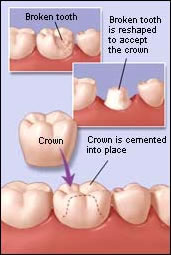A crown, also known as a cap, is a tooth-shaped covering that is placed over a tooth to protect and keep badly decayed or fractured teeth or to cosmetically improve the natural appearance of teeth.
The Procedure: Decay is removed and cleaned from the tooth, and then the tooth is reshaped to accommodate the crown. A highly accurate impression or mold is made of the prepared surface, and then a temporary crown is placed over the prepared tooth. This mold is used to create a model of thetooth, which is then sent to a special laboratory that will create a crown. The crown is then cemented onto the prepared surface of the tooth. There are 3 types of dental crowns: Porcelain Crown: matches the shade and shape of the tooth more than any other type of crown, virtually undetectable. It is not as strong as Porcelain Fused to Metal. It is ideal for front teeth.
Metal Crown: less tooth structure needs to be removed; adjacent tooth wear is kept to a minimum. The main disadvantage is the color of the metal.
Porcelain Fused to Metal (PMF) Crowns: are stronger than Porcelain crowns and it matches the shade of the adjacent teeth. It is ideal for back teeth and can also be used for front teeth.
You and your dentist will decide which type is appropriate depending upon the strength requirements and esthetic concerns of the tooth involved.
| The Problem: - Badly decayed teeth
- Fractured teeth
- Sensitive Teeth
- Weak teeth, need to protect and strengthen teeth especially after root canal or a tooth that cannot be filled again.
- Unpleasant natural appearance of teeth: malformed, malpositioned or discolored teeth
The Solution: - Place a crown on the tooth to cover it and restore it to its original shape and size.

|